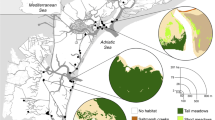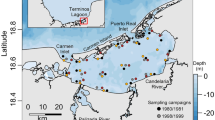Abstract
Estuaries are one of the most threatened ecosystems, with a great number of stressors related to pollution, hydromorphological changes, and invasive species. However, the response of the biological indicators proposed for their ecological status assessment is not always well established. When using estuarine vegetation (saltmarshes and seagrasses) as an indicator, there are several theoretical concepts regarding the relationships between the variations of this indicator and hydromorphological stressors. It is precisely these relationships which are presented in this work. To carry out this objective, based on the first intercalibration process, a set of metrics for saltmarsh and seagrass taxonomic compositions (e.g., loss of number of taxa and richness) and abundance (e.g., relative coverage and relative extent) have been selected and applied to different estuaries located in Northern Spain. Additionally, a methodology for the hydromorphological status assessment, based on the analysis of the anthropogenic changes in the hydrodynamic and morphological estuarine characteristics (e.g., the extension of land claim areas or changes in the estuarine perimeter), has been developed and applied to these transitional water bodies in order to find a gradient of pressured sites in which we seek correlations between the vegetation metrics and hydromorphological stressors. As a result, the response of the different vegetation indicators is variable. In some cases, a negative correlation of the indicator with the pressure degree exists, whereas in other cases, the relationship is not as clear. Nonetheless, according to the results, it can be suggested that the placing of anthropogenic structures diminishes the quality of the estuarine vegetation. Therefore, to maintain a suitable environment for the estuarine vegetation seems necessary in order to reduce the number of the hydrodynamic structures which are no longer in use.


Similar content being viewed by others
References
Associated British Ports. 2005. Technical assessment method. Morphological Alterations.
Adams, S.M. 2005. Using multiple response bioindicators to assess the health of estuarine ecosystems: an operational framework. In Estuarine indicators, ed. S.A. Bortone. USA: Routledge.
Besada, V., J.M. Andrade, F. Schultze, and J.J. González. 2010. Comparision of the 2000 and 2005 spatial distribution of heavy metals in wild mussels from the North-Atlantic Spanish coast. Ecotoxicology and Environmental Safety. doi:10.1016/j.ecoenv.2010.10.002.
Boorman, L. 2003. Saltmarsh review. An overview of coastal saltmarshes, their dynamic and sensitivity characteristics for conservation and management. Peterborough: JNCC.
Borja, A., J. Franco, and V. Pérez. 2000. A marine biotic index to establish the ecological quality of soft-bottom benthos within European estuarine and coastal environments. Marine Pollution Bulletin 40: 1100–1114.
Bowen, J.L., and I. Valiela. 2001. The ecological effects of urbanization of coastal watersheds: historical increases in nitrogen loads ans eutrophication of Waquoit Bay estuaries. Canadian Journal of Fisheries and Aquatic Science 58: 1489–1500.
Branch, G. 1999. Estuarine vulnerability and ecological impacts. In Estuaries of South Africa, ed. B.R. Allanson and D. Baird, 340. Cambridge: Cambridge University Press.
Bricker, S.B., J.G. Ferreira, and T. Simas. 2003. An integrated methodology for assessment of estuarine trophic status. Ecological Modelling 169: 39–60.
Bueno, A. 1996. Flora y vegetación de los estuarios asturianos. Oviedo: Universidad de Oviedo.
IH Cantabria, 2010. Plan Hidrológico de las masas de agua de transición y costeras de Cantabria, Consejería de Medio Ambiente del Gobierno de Cantabria, Santander
Cheroske, A.G., S.L. Williams, and R.C. Carpenter. 2000. Effects of physical and biological disturbances on algal turfs in Kaneohe Bay, Hawaii. Journal of Experimental Marine Biology and Ecology 248: 1–34.
Commission, European. 2003. Interpretation manual of European Union habitats. DG Environment: European Commission.
Coops, H., R. Boeters, and H. Smit. 1991. Direct and indirect effects of wave attack on helophytes. Aquatic Botany 41: 333–352.
Dauvin, J.C., N. Desroy, A.L. Janson, C. Vallet, and S. Duhamel. 2006. Recent changes in estuarine benthic and suprabenthic communities resulting from the development of harbour infrastructure. Marine Pollution Bulletin 53: 80–90.
Puertos del Estado. 2007. Programa de clima maritimo de Puertos del Estado, Ministerio de Fomento.
Dennison, W.C., et al. 1993. Assessing water quality with submersed aquatic vegetation. Bioscience 43: 86–94.
Dodson, S.I., R.A. Lillie, and S. Will-Wolf. 2005. Land use, water chemistry, aquatic vegetation, and zooplankton community structure of shallow lakes. Ecological Applications 15: 1191–1198.
Egertson, C.J., J.A. Kopaska, and J.A. Downing. 2004. A century of change in macrophyte abundance and composition in response to agricultural eutrophication. Hydrobiologia 524: 145–156.
Elliott, M., T.F. Fernandes, and V.N. de Jonge. 1999. The impact of recent European Directives on estuarine and coastal science and management. Aquatic Ecology 33: 311–321.
European Commission. 1992. Council Directive 92/43/EEC of 21 May 1992 on the conservation of natural habitats and of wild fauna and flora. Official Journal of the European Communities.
European Commission. 2000. Directive 2000/60/EC of the European Parliament and of the Council of 23 October 2000 establishing a framework for community action in the field of water policy. Official Journal of the European Communities.
European Commission. 2009a. Water Framework Directive intercalibration technical report, Joint Research Center, Institute for Environmental and Sustainability.
European Commission. 2009b. WFD Intercalibration phase 2: milestone 2 report.
Foden, J., S.I. Rogers, and A.P. Jones. 2008. A critical review of approaches to aquatic environmental assessment. Marine Pollution Bulletin 56: 1825–1833.
Fonseca, M.S., and S.S. Bell. 1998. Influence of physical setting on seagrass landscapes near Beaufort, North Carolina, USA. Marine Ecology Progress Series 171: 109–121.
Galvan, C., J.A. Juanes, and A. Puente. 2010. Ecological classification of European transitional waters in the North-East Atlantic eco-region. Estuarine, Coastal and Shelf Science 87: 442–450.
García, A., et al. 2008. Surface water resources assessment in scarcely gauged basins in the north of Spain. Journal of Hydrology 356: 312–326.
García, P., E. Zapico, and A. Colubi. 2009. An angiosperm quality index (AQI) for Cantabrian estuaries. Ecological Indicators 9(5): 856–865.
González-Alcaraz, M.N. et al. 2011. The combined use of liming and Sarcocornea fruticosa development for phytomanagement of salt marsh soils polluted by mine wastes. Journal of Hazardous Materials 186: 805–813
Gosset, W.S. 1908. The probable error of a mean. Biometrika 6: 1–25.
Guinda, X. et al. 2013. Application of landscape mosaics for the biological quality assessment of subtidal macroalgae communities using the CFR index. Deep-Sea Research II. Accepted
Irabien, M.J., A. Cearreta, E. Leorri, J. Gómez, and J. Viguri. 2008. A 130 year of pollution in the Suances estuary (southern Bay of Biscay): implications for environmental management. Marine Pollution Bulletin 56: 1719–1727.
Jacob, D.L., and M.L. Otte. 2003. Conflicting processes in the wetland plant rhizosphere: metal retention or mobilization? Water, Air, and Soil Pollution 3: 91–104.
Kaiser, M.J. 2003. Detecting the effects of fishing on seabed community diversity: importance of scale and sampling size. Conservation Biology 17: 512–520.
Keddy, P.A. 1983. Shoreline vegetation in Axe Lake, Ontano: effects of exposure on zonation patterns. Ecology 64: 331–344.
Kennish, M.J. 2002. Environmental threats and environmental future of estuaries. Environmental Conservation 29: 78–107.
Krause-Jensen, D., M.F. Pedersen, and C. Jensen. 2003. Regulation of eelgrass (Zostera marina) cover along depth gradients in Danish coastal waters. Estuaries 26: 866–877.
Krause-Jensen, D., J. Carstensen, and K. Dahl. 2007. Total and opportunistic algal cover in relation to environmental variables. Marine Pollution Bulletin 55: 114–125.
Lemoine, C., and Claustres, G. 1994. Connaître et Reconnaître La Flore et la Végétation des côtes Manche-Atlantique, Rennes, 332 pp.
Lewis, L.J., J. Davenport, and T.C. Kelly. 2003. A study of the impact of a pipeline construction on estuarine benthic invertebrate communities. Part 2. Recolonization by benthic invertebrates after 1 year and response of estuarine birds. Estuarine Coastal and Shelf Science 47: 201–208.
McCall, P. 1977. Community patterns and adaptive strategies of the infaunal benthos of Long Island Sound. Journal of Marine Research 35: 221–265.
McIntyre, N.R., T. Wagener, H.S. Wheater, and Z.S. Yu. 2003. Uncertainty and risk in water quality modelling and management. Journal of Hydroinformatics 5(4): 259–274.
McLusky, D.S., and M. Elliott. 2004. The estuarine ecosystem ecology, threats and management. Oxford: Oxford University Press.
Milan, O. 2007. Correlations between several environmental factors affecting the bloom events of cyanobacteria in Liptovska Mara reservoir (Slovakia)—a simple regression model. Ecological Modelling 209: 412–416.
Norkkon, A., R. Rosenberg, S.F. Thrush, and R.B. Whitlatch. 2006. Scale- and intensity-dependent disturbance determines the magnitude of opportunistic response. Journal of Experimental Marine Biology and Ecology 330: 195–207.
Noss, R.F. 1999. Assessing and monitoring forest biodiversity: a suggested framework and indicators. Forest Ecology and Management 115: 135–146.
Orfanidis, S., E. Panayotidis, and N. Stamatis. 2003. An insight to the Ecological Evaluation Index (EEI). Ecological Indicators 3: 27–33.
Otte, M.L. 2001. What is stress to a wetland plant? Environmental and Experimental Botany 46: 195–202.
Otte, M.L., M.S. Haarsma, R.A. Broekman, and J. Rozema. 1993. Relation between heavy metal concentrations in salt-marsh plants and soils. Environmental Pollution 82: 13–22.
Park, R.A., J.S. Clough, and M. Coombs Wellman. 2008. AQUATOX: modeling environmental fate and ecological effects in aquatic ecosystems. Ecological Modelling 213: 1–15.
Parravicini, V., et al. 2009. Size matters more than method: visual quadrats vs photography in measuring human impact on Mediterranean rocky reef communities. Estuarine, Coastal and Shelf Science 81: 359–367.
Puente, A., et al. 2008. Ecological assessment of soft bottom benthic communities in northern Spanish estuaries. Ecological Indicators 8: 373–388.
Walker, D.I., and A.J. McComb. 1992. Seagrass degradation in Australian coastal waters. Marine Pollution Bulletin 25: 191–195.
Wilkinson, M., Wood, P., Wells, E. and Scanlan, C. 2006. Using attached macroalgae to assess ecological status of British for the European Water Framework Directive. Marine Pollution Bulletin
Acknowledgments
This work has been partly funded by the Department of Environment and by the Department of Rural Development, Cattle, Agriculture, Fisheries and Biodiversity (Government of Cantabria).
Author information
Authors and Affiliations
Corresponding author
Rights and permissions
About this article
Cite this article
Recio, M., Ondiviela, B., Puente, A. et al. The Influence of Hydromorphological Stressors on Estuarine Vegetation Indicators. Estuaries and Coasts 36, 997–1005 (2013). https://doi.org/10.1007/s12237-013-9607-2
Received:
Revised:
Accepted:
Published:
Issue Date:
DOI: https://doi.org/10.1007/s12237-013-9607-2




